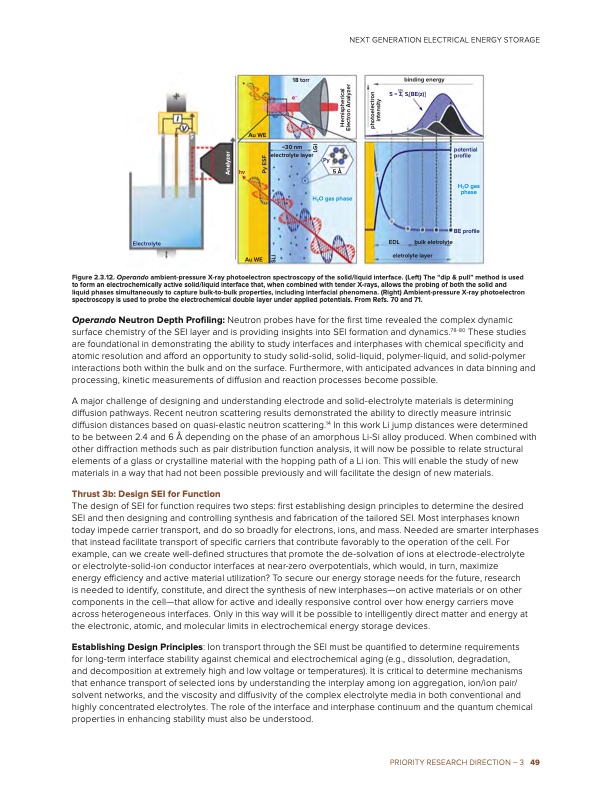
PDF Publication Title:
Text from PDF Page: 055
Electrolyte bulk eletrolyte hv 5 Å Au WE Au WE Figure 2.3.12. Operando ambient-pressure X-ray photoelectron spectroscopy of the solid/liquid interface. (Left) The “dip & pull” method is used to form an electrochemically active solid/liquid interface that, when combined with tender X-rays, allows the probing of both the solid and liquid phases simultaneously to capture bulk-to-bulk properties, including interfacial phenomena. (Right) Ambient-pressure X-ray photoelectron spectroscopy is used to probe the electrochemical double layer under applied potentials. From Refs. 70 and 71. Operando Neutron Depth Profiling: Neutron probes have for the first time revealed the complex dynamic surface chemistry of the SEI layer and is providing insights into SEI formation and dynamics.78-80 These studies are foundational in demonstrating the ability to study interfaces and interphases with chemical specificity and atomic resolution and afford an opportunity to study solid-solid, solid-liquid, polymer-liquid, and solid-polymer interactions both within the bulk and on the surface. Furthermore, with anticipated advances in data binning and processing, kinetic measurements of diffusion and reaction processes become possible. A major challenge of designing and understanding electrode and solid-electrolyte materials is determining diffusion pathways. Recent neutron scattering results demonstrated the ability to directly measure intrinsic diffusion distances based on quasi-elastic neutron scattering.14 In this work Li jump distances were determined to be between 2.4 and 6 Å depending on the phase of an amorphous Li-Si alloy produced. When combined with other diffraction methods such as pair distribution function analysis, it will now be possible to relate structural elements of a glass or crystalline material with the hopping path of a Li ion. This will enable the study of new materials in a way that had not been possible previously and will facilitate the design of new materials. Thrust 3b: Design SEI for Function The design of SEI for function requires two steps: first establishing design principles to determine the desired SEI and then designing and controlling synthesis and fabrication of the tailored SEI. Most interphases known today impede carrier transport, and do so broadly for electrons, ions, and mass. Needed are smarter interphases that instead facilitate transport of specific carriers that contribute favorably to the operation of the cell. For example, can we create well-defined structures that promote the de-solvation of ions at electrode-electrolyte or electrolyte-solid-ion conductor interfaces at near-zero overpotentials, which would, in turn, maximize energy efficiency and active material utilization? To secure our energy storage needs for the future, research is needed to identify, constitute, and direct the synthesis of new interphases—on active materials or on other components in the cell—that allow for active and ideally responsive control over how energy carriers move across heterogeneous interfaces. Only in this way will it be possible to intelligently direct matter and energy at the electronic, atomic, and molecular limits in electrochemical energy storage devices. Establishing Design Principles: Ion transport through the SEI must be quantified to determine requirements for long-term interface stability against chemical and electrochemical aging (e.g., dissolution, degradation, and decomposition at extremely high and low voltage or temperatures). It is critical to determine mechanisms that enhance transport of selected ions by understanding the interplay among ion aggregation, ion/ion pair/ solvent networks, and the viscosity and diffusivity of the complex electrolyte media in both conventional and highly concentrated electrolytes. The role of the interface and interphase continuum and the quantum chemical properties in enhancing stability must also be understood. Py potential profile H2O gas phase BE profile H2O gas phase NEXT GENERATION ELECTRICAL ENERGY STORAGE 18 torr e– ~30 nm electrolyte layer binding energy EDL S = Σi Si[BE(z)] EDL eletrolyte layer PRIORITY RESEARCH DIRECTION – 3 49 SLI Analyzer Py ESF LGI CE RE WE Hemispherical Electron Analyzer photoelectron intensityPDF Image | Next Generation Electrical Energy Storage

PDF Search Title:
Next Generation Electrical Energy StorageOriginal File Name Searched:
BRN-NGEES_rpt-low-res.pdfDIY PDF Search: Google It | Yahoo | Bing
Sulfur Deposition on Carbon Nanofibers using Supercritical CO2 Sulfur Deposition on Carbon Nanofibers using Supercritical CO2. Gamma sulfur also known as mother of pearl sulfur and nacreous sulfur... More Info
CO2 Organic Rankine Cycle Experimenter Platform The supercritical CO2 phase change system is both a heat pump and organic rankine cycle which can be used for those purposes and as a supercritical extractor for advanced subcritical and supercritical extraction technology. Uses include producing nanoparticles, precious metal CO2 extraction, lithium battery recycling, and other applications... More Info
| CONTACT TEL: 608-238-6001 Email: greg@infinityturbine.com | RSS | AMP |